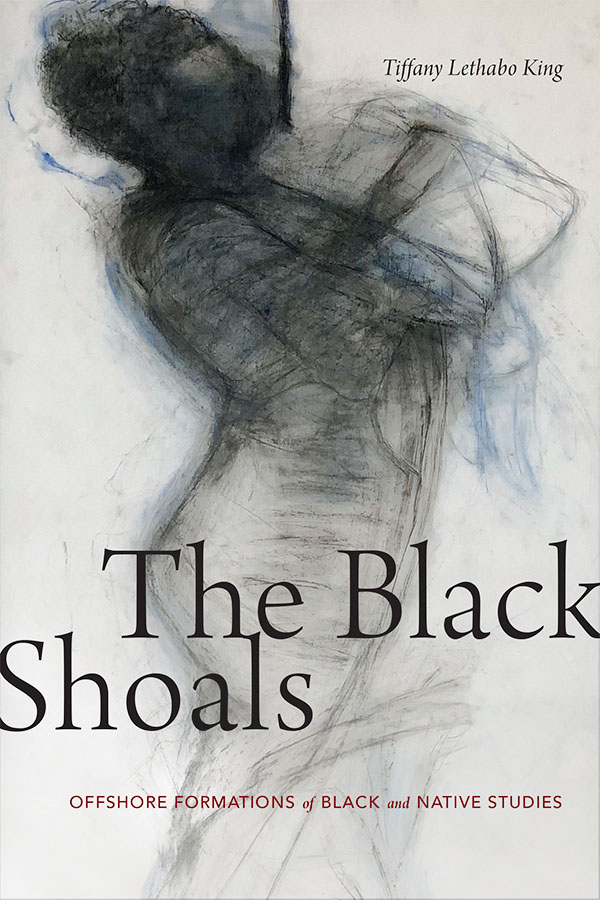The shoal is liminal, indeterminate, and hard to map. As elements of the ocean that not are stable or readily mappable and therefore knowable, shoals slow the movement of a vessel. They cause the ship’s velocity and momentum to change direction, to adjust, and on occasion they force the voyage to stop. The shoal is an impediment and a danger to navigation. Materially, it is a site where movement as usual cannot proceed. […] Rising and falling with the tide, the shoal is an interstitial and emerging space of becoming […]
the Black shoal is certainly a moment of friction and the production of a new topography. The Black Shoals, as an analytical and a methodological location, constitutes a moment of convergence, gathering, reassembling, and coming together (or apart). The shoal, like Black thought, is a place where momentum and velocity as normal vectors are impeded. It is the place where an adjustment needs to be made. As an in-between, ecotonal, unexpected, and shifting space, the shoal requires new footing, different chords of embodied rhythms, and new conceptual tools to navigate its terrain. The shoal enables this book to shift its conceptual lens to a liminal space between the sea and the land.
At its surface, the shoal functions as a space of liminality, indeterminacy, and location of suture between two hermeneutical frames that have conventionally been understood as sealed off from each other. I offer the space of the shoal as simultaneously land and sea to fracture this notion that Black diaspora studies is overdetermined by rootlessness and only metaphorized by water and to disrupt the idea that Indigenous studies is solely rooted and fixed in imaginaries of land as territory. Scholars in Black diaspora studies, giving specific attention to late twentieth-century scholars, have mobilized oceanic and water metaphors to theorize Black life, aesthetics, and decolonial politics as breaks with continental European discourse. Similarly positioning itself as a challenge to Western and colonial epistemes, Native studies has centered land at the fulcrum of its analytical, theoretical, and metaphorical maneuvers that challenge coloniality. The shoal creates a rupture and at the same time opens up analytical possibilities for thinking about Blackness as exceeding the metaphors and analytics of water and for thinking of Indigeneity as exceeding the symbol and analytic of land
King, T. L. (2019: 3-4). Introduction: The Black Shoals. In The Black Shoals: Offshore Formations of Black and Native Studies (pp. 1–35). Durham, NC: Duke University Press.
Tiffany Lethabo King usa una figura intersticial maravillosa, marina a la vez que terrestre: el «black shoal», el banco de arena negra de playa para pensar ese lugar entre, donde se junta lo subterráneo y lo submarino (figuras que parecen cautivar a lxs pensadores negrxs abolicionistas, que no quieren olvidar el ahogo de la esclavitud y su ligazón inextricable con el mar, pero tampoco con la forma en que su humanidad ha sido ahogada, tratados siempre como menos que humanos: o cuyo humanismo no era dado por sentado) con lo terrestre (figuras que en el pensamiento amerindio han cautivado para pensar otras cosmovisiones o figuraciones alternativas al extractivismo y las nociones liberales de propiedad: que no sólo marcaban de quién era qué, sino qué eran las cosas frente a los sujetos).
El banco de arena negra como lugar de encuentro que supura violencia, donde pudieran intentar juntarse (coming together or apart) aquellos que el proyecto colonial separó, a unos como «esclavos» y a otros como «salvajes»:
1) Intriga ese proyecto de cooperación intersticial entre comunidades excluidas por el proyecto moderno, pero cuya forja de alianzas es compleja, porque cada uno representa una arista de la otredad moderna que no casa bien entre sí – ¿quizá el principal enemigo de un proyecto interseccional, buscando en-tender puentes entre diferentes fuentes de violencia y exclusión, sea esa cosa de que cada una de esas diferencias son un silo en sí mismo? Cada uno de esos destrozados por el proyecto moderno lidia con sus expertos en su exclusión/inclusión que no son los mismos, remiten a saberes distintos, etc.
2) Pero lo interesante es que la posibilidad de intersticio a veces se niega internamente, en la dinámica perpetua en que cada grupo (raza, discapacidad, género, etnias, etc.) tal y como ha sido dividido por la métrica modernista y sus profesionales de la división concreta, es que a su vez cada cual tiene una lucha entre una cohorte de asimilacionistas internos (esa minoría que anula su condición como tal: el Tío Tom) que ahoga y destruye cualquier intento de conexiones no-asimilacionistas con otrxs.

1 thought on “Lethabo King: Black shoals”
Comments are closed.